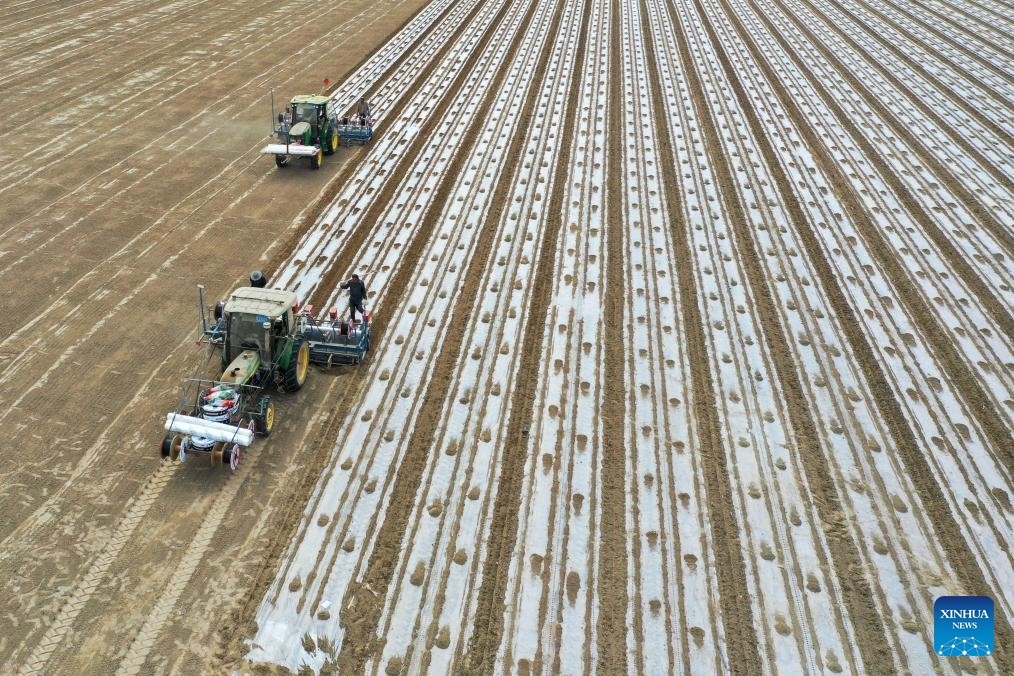
A drone photo shows self-driving seeders working in the farmland in Awat County of Aksu, northwest China’s Xinjiang Uygur Autonomous Region, March 27, 2024. Xinjiang is a major hub of cotton production. As the temperature rises, the spring sowing of cotton in Xinjiang kicked off from south to north. In recent years, advancements in agricultural technology have gradually become vital allies to the farmers of Xinjiang. From planting to harvesting, mechanization and intelligent facilities have been widely applied.(Photo: Xinhua)
One of the important tasks of agricultural work in 2025 will be the continued increase of grain and oil crop yields in large areas, Pan Wenbo, chief agronomist and an official with the Ministry of Agriculture and Rural Affairs (MOA), said on Monday at a press conference.
“Over the past two years, China’s grain production has been able to achieve stable and increased yields, largely thanks to per unit yield improvements,” Pan said.
Pan noted that efforts to increase the per unit yield will be put into realizing yield improvement in larger areas. There is a greater emphasis on the integration of good fields, good seeds, good machinery, and good methods, all of which work together to increase per unit yield.
In 2024, the MOA initiated and implemented a project to increase the per unit yield of grain and oil crops, which achieved preliminary success. The annual per unit yield of grain increased by 5.1 kilograms compared with the previous year, with the improvement in per unit yield contributing to more than 80 percent of the increase in production, said Pan.
During the Central Rural Work Conference held in Beijing from December 17 to 18, 2024, it was noted that efforts should be concentrated on increasing per unit yields of grain and oil crops on a large scale, and other aspects, according to the Xinhua News Agency.
The year 2025 is the end of the 14th Five-Year Plan (2021-25) and the last year of a five-year transition period to consolidate and expand the achievements of poverty alleviation and effectively link rural revitalization. The MOA will put efforts into optimizing the efficiency of assistance, strengthening the quality of industrial employment and deepening support in key regions’ development, Zhang Xingwang, vice minister of agriculture and rural affairs, also said at the Monday press conference.
The focuses of agricultural work in 2025 mentioned in the Monday conference are in line with that of the annual Central Rural Work Conference, Wang Gangyi, a professor at Northeast Agricultural University, told the Global Times on Monday.
“In terms of guaranteeing production output, the conference mapped out specific measures to stabilize areas sown with grain, increase the per unit yield of grain and oil crops, strengthen the protection and quality of cultivated land, and promote agricultural science and technology,” said Wang.
“Stabilizing yield per unit mainly relies on developing new quality productive forces, namely applying digital technology to agriculture. However, the main focus, I believe, will be on promoting large-scale high-density planting,” Li Guoxiang, a research fellow at the Rural Development Institute of the Chinese Academy of Social Sciences, told the Global Times on Monday.
The level of agricultural modernization in China continued to improve in 2024. The comprehensive mechanization rate of crop cultivation, harvesting, and planting is expected to have exceeded 75 percent, said Zhang.
As a result, grain production overcame the impact of natural disasters such as high temperatures and droughts, extreme floods, and super typhoons, achieving another bumper harvest in 2024, according to Zhang.
Zhang noted that for the first time, the grain output exceeded 1.4 trillion jin (700 billion tons), reaching 1.413 trillion jin in 2024, an increase of 22.18 billion jin over 2023.
The achievements in expanding the cultivation of soybeans and oil crops have been effectively consolidated, with soybean production reaching 20.65 million tons, further increasing the self-sufficiency rate of edible vegetable oils. The stable supply of cotton, sugar, and rubber has been maintained, and the production of pork, beef, mutton, and poultry meat has reached 96.63 million tons, an increase of 0.2 percent year-on-year, said Zhang.
The supply of meat, eggs, milk, fruits, vegetables, tea, and aquatic products is sufficient, with an increase in the supply of green and high-quality agricultural products, making the dining tables of the people richer and their diets more nutritious and healthy, Zhang introduced.
The importance of ensuring food security is always a priority in China’s agricultural work, Wang noted.

